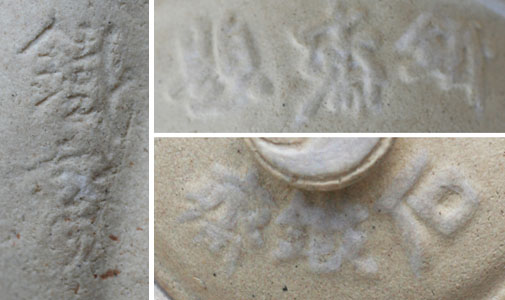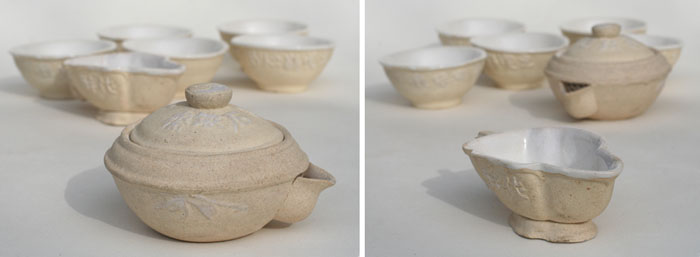tea
Sencha tea set: teapot - Hohin, water cooler - yuzamashi and 5 tea cups - yunomiSigned: Tessai and Tessai dai
Seals:
Technique: Beige coloured Kyoyaki with moulded inscription heightened with white、and glazed interiors
Condition: Chip at the footring of the cooler, otherwise very good
宝瓶 Hohin (Teapot) Ø 9,8 (11,3) x 7
湯冷 Yuzamashi (water cooler), 12 x 6,5 x 4,4
茗碗 Yunomi (tea cups), Ø 8,8 x 4
Inscription hohin lid: 眠雲跂石 Min'un shiseki - Sleeping among clouds (on a mountain) sitting on a rock with legs hanging over.
inscription yuzamashi: 酌茗代醉 Shakumei daisui - Pouring tea rather than getting tipsy
Inscription yunomi: 更覺鶴心通杳冥 Moto yori kashin tsuu yômei
Even more I feel my soul levitate like a crane through the infinite heavens.
Quote from a poem by Wen Tingyun 溫庭筠 (812–870): 西陵道士茶歌 - Song of the tea by the taoist of the Xiling): 疏香皓齒有餘味,更覺鶴心通杳冥。
The perfumed flavor of the tea I can still feel in my mouth,
and levitate the soul as a crane through the infinite heavens.
Tomioka Tessai was born in Kyoto into a family selling robes and accessories for the Buddhist clergy. As a result of a childhood illness he became partly deaf. It was therefore considered improbable that he would ever become a successful shopkeeper. Instead he went to study the Japanese classics in order to become a Shinto priest. He also did Chinese studies, specializing in the teachings of the neo-confucianist Wang Yang-Ming. Later he would study Buddhism, literature and Shingaku, a semi-religious system for self-cultivation. As a youth he met Ōtagaki Rengetsu (1791-1875) and became her special protégé. She taught him waka and encouraged his artistic inclinations. In the final years of the Tokugawa era Tessai was involved in the pro-imperialist movement. For fear of being arrested he left Kyoto in 1861 and travelled to Nagasaki. It was the first of many trips; Tessai became and avid traveller. In 1882 he settled in Kyoto where he spent the rest of his life. Although he worked as a priest at several Shinto shrines, he saw painting as his chief occupation. Between 1894 and 1904 he was a teacher at the Kyoto Prefectural Art School and he was a regular contributor to exhibitions of the Nanga Society. In 1917 he was appointed Artist to the Imperial Household and towards the end of his life he received an honorary court-rank. Tessai is often seen as the last great exponent of the Nanga school. (AB)
Reference:
Kanazawa
Kato 1998
Roberts p. 181
Araki pp. 2754-2755
Aburai pp. 266-267
Morioka & Berry ‘99 pp. 116-121 (# 20-21)
Morioka & Berry ‘08 p. 305-06 (# 11, 46)
Price: ON REQUEST

